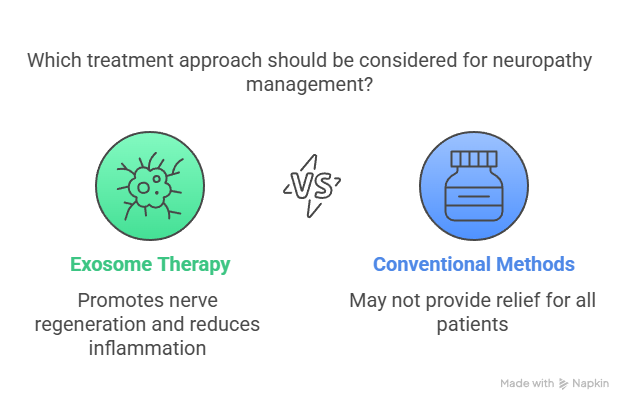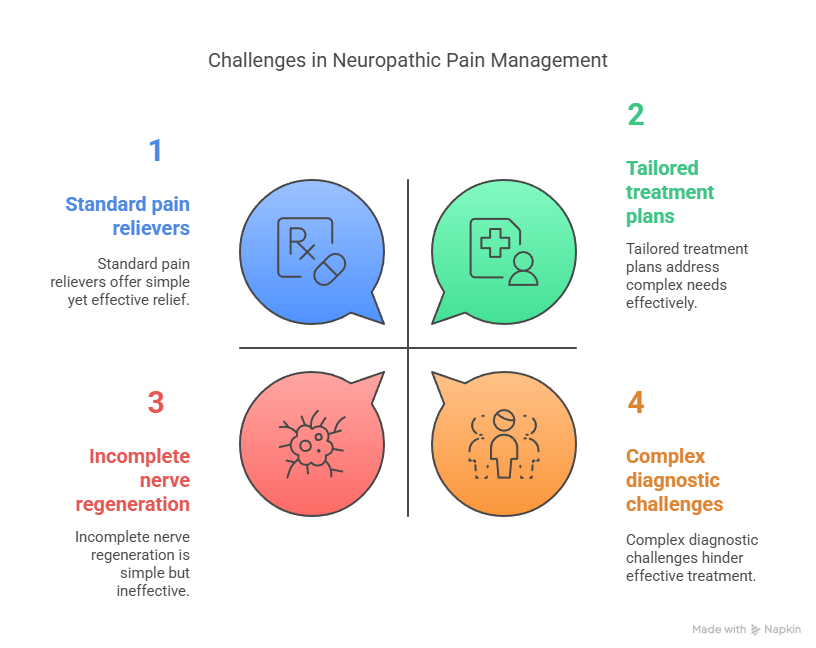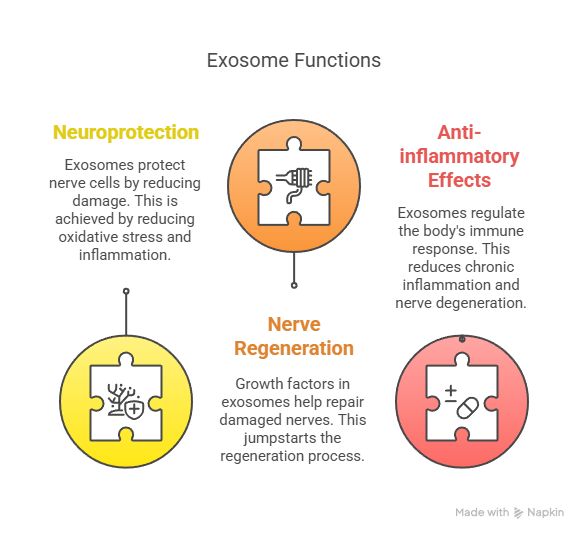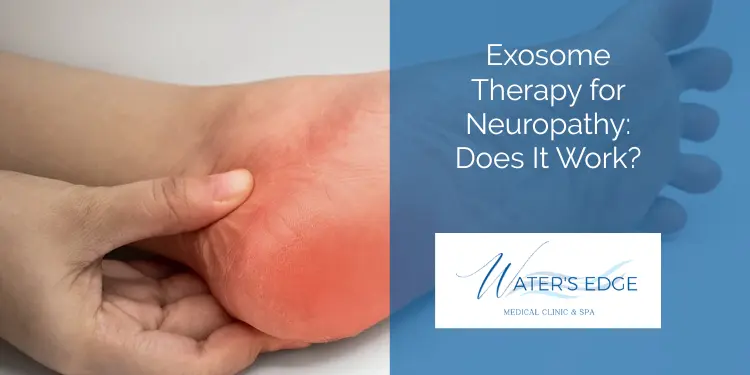Exosome therapy for neuropathy is gaining attention as a potential new treatment for nerve damage. Neuropathy can be a frustrating condition, often causing pain, numbness, and weakness. Traditional treatments sometimes fall short, leaving many people searching for alternatives. This article explores what neuropathy is, how exosome therapy works, and whether it might be an effective option for those suffering from nerve-related issues.

Key Takeaways
- Exosome therapy for neuropathy aims to promote nerve regeneration and reduce inflammation, potentially improving symptoms.
- This treatment is particularly considered for patients who haven’t found relief through conventional methods.
- While research is ongoing, early studies suggest that exosome therapy may offer a promising alternative for managing neuropathy.
What Is Neuropathy and Why Is It So Difficult to Treat?
Neuropathy, at its core, is a malfunction of the peripheral nerves. This condition occurs when the nerves are damaged or stop functioning properly, causing symptoms that can greatly affect daily life. It’s not just one disease, but rather a collection of disorders with similar symptoms but diverse underlying causes.

Why is it so tough to treat? Well, several factors contribute to the difficulty. First off, the causes are incredibly varied. Diabetes is a big one, but so are autoimmune diseases, infections, and even exposure to toxins. Pinpointing the exact cause can be a diagnostic maze. Then, there’s the fact that nerve damage is often slow to heal, if it heals at all. Nerves regenerate at a snail’s pace, and sometimes the damage is simply too extensive for the body to repair effectively.
Plus, pain management is a huge challenge. Neuropathic pain is different from regular pain; it’s often described as burning, stabbing, or electric shock-like, and it doesn’t always respond well to traditional pain medications. Finding what is the most effective treatment for neuropathy that works for each individual can be a long and frustrating process.
Neuropathy is a complex condition because it can stem from many different causes, slow nerve regeneration, and the unique characteristics of neuropathic pain. Successfully managing the condition involves a comprehensive approach that targets the root cause, promotes nerve healing, and provides adequate pain relief.
Here are some reasons why neuropathy is difficult to treat:
- Diverse underlying causes make accurate diagnosis challenging.
- Nerve regeneration is a slow and often incomplete process.
- Neuropathic pain doesn’t always respond well to typical pain relievers.
- The most effective care is tailored to the individual’s specific needs and underlying issues.
Understanding Exosome Therapy and Its Role in Healing
Exosome therapy is a pretty new area in regenerative medicine, and it’s showing some real promise for treating neuropathy. Basically, exosomes are tiny little bubbles released by cells. They’re packed with proteins, lipids, and genetic stuff. They’re super important for cells to talk to each other, and they can carry therapeutic stuff to specific cells. It’s like sending a targeted message to fix what’s broken.
Exosome therapy for neuropathy has a complex mode of action that includes neurodegenerative, neuroprotective, angiogenic, anti-inflammatory, and immunomodulatory effects.
One of the big advantages of exosome therapy is its regenerative potential.
Exosomes derived from stem cells—particularly mesenchymal stem cells (MSCs), have bioactive chemicals that can help with nerve regeneration and repair. Plus, it’s minimally invasive. You can get exosome treatment in a few ways, like a shot right where the damage is, such as into a joint, tendon, ligament or muscle, or it can be administered intravenously. This means less pain and risk compared to more intense treatments. It also opens the door for personalized medicine. Exosomes can be taken from different cell sources and changed to carry specific therapeutic cargo, this helps us design a personalized treatment plan that fits your unique situation.
It’s important to remember that deciding if exosome therapy is right for you depends on a few things, like how bad your symptoms are, the type of neuropathy you have, and your overall health. You should always talk to a doctor who knows about neurology and regenerative medicine to see if you’re a good fit and to create a treatment plan that works for you. They can help you figure out where to get exosome therapy and if it’s the right choice for your situation. It’s also important to understand how long does exosome therapy last and what the expected outcomes are.
How Exosome Therapy Targets Nerve Damage in Neuropathy
Exosome therapy is gaining attention as a potential treatment for neuropathy because of its unique approach to addressing nerve damage. Unlike conventional therapies that mainly address symptoms, exosome therapy aims to promote nerve regeneration and repair. It’s a different way of thinking about how to deal with this difficult condition. Let’s explore how this therapy works on a deeper level.

Exosomes, tiny vesicles secreted by cells, carry a cargo of proteins, RNA, and other molecules that can influence the behavior of other cells. When it comes to neuropathy, exosomes from mesenchymal stem cells (MSCs) are especially promising. These MSC-derived exosomes are packed with growth factors and anti-inflammatory molecules, making them well-suited to address the complex challenges of nerve damage. It’s like sending a repair crew directly to the site of the problem.
Here’s a breakdown of how exosome therapy works to target nerve damage:
- Neuroprotection: Exosomes can protect nerve cells from further damage by reducing oxidative stress and inflammation.
- Nerve Regeneration: These growth factors help jumpstart the repair process in damaged nerves, aiding regeneration.
- Anti-inflammatory Effects: Exosomes have the ability to influence and regulate the body’s immune response, reducing chronic inflammation that contributes to neuropathic pain and nerve degeneration.
Exosome therapy represents a shift towards regenerative medicine for neuropathy, aiming to restore nerve function rather than just mask symptoms. This method shows potential to enhance long-term recovery for those living with this challenging condition.
Promising results suggest this strategy could significantly improve quality of life over time, it’s still a relatively new field. More research is needed to fully understand its long-term effects and optimal application. Patients considering this therapy should consult with licensed medical professionals who specializes in neuropathy to determine if it’s the right option for them. The potential benefits are exciting, but a careful and informed approach is essential. Recent advancements in regenerative medicine are helping to refine treatment strategies for neuropathy through stem cell therapy.
Clinical Research and Patient Outcomes: Does It Really Work?
It’s natural to wonder if exosome therapy for neuropathy actually works. The answer, like with many medical treatments, is complex and still developing. While the science behind it is promising, the amount of robust clinical data is still growing. Let’s take a look at what the current research shows and what patients are saying.
Some early studies suggest that exosomes can indeed play a role in nerve regeneration and reducing inflammation, which are key factors in neuropathy. However, it’s important to keep in mind that many of these studies are preliminary, and more extensive, controlled trials are needed to confirm these findings. It’s also worth noting that the source and preparation of exosomes can vary, which could affect the results.
Patient experiences are also mixed. Many patients have experienced noticeable relief from their symptoms, such as reduced pain, increased sensation, and better mobility. Others may experience more modest benefits, or none at all. It’s crucial to have realistic expectations and to understand that exosome therapy is not a guaranteed cure for neuropathy. Individual responses can vary widely depending on the type and severity of neuropathy, as well as other health factors.
A balanced view is essential when considering exosome therapy—recognizing both its promise and the gaps in current research. Talking with a trusted healthcare provider is the best way to find out if this treatment suits your needs.
For example, Schwann cell-derived exosomes have shown promise in nerve repair.
What to Expect From Treatment: Benefits, Risks, and Costs
Okay, so you’re thinking about exosome therapy for your neuropathy. It’s natural to wonder what you’re signing up for. Here’s a clear look at what you can expect from this treatment, covering the good, the not-so-good, and the financial aspect.
Potential Benefits
First, let’s talk about what could happen. It’s important to keep expectations in check, but there are some promising possibilities.
- Pain Reduction: This is a big one for many neuropathy sufferers. Some people report a noticeable decrease in pain levels after treatment. It might not be a complete elimination, Even small improvements can have a big impact on daily comfort and well-being.
- Improved Nerve Function: The goal here is to help regenerate damaged nerves. This could translate to better sensation, improved motor skills, and just an overall feeling of things working a bit better.
- Enhanced Healing: If you have ulcers or wounds related to your neuropathy, exosome therapy might help speed up the healing process. This is because exosomes can promote cell growth and reduce inflammation.
Possible Risks and Side Effects
Now for the less fun part. Like any medical treatment, exosome therapy isn’t without its potential downsides. While generally considered safe, it’s important to be aware of these:
- Injection Site Reactions: Redness, swelling, or pain at the injection site are possible. These are usually mild and temporary, but it’s still something to keep in mind.
- Flu-Like Symptoms: A few individuals may notice mild, flu-like symptoms following treatment, such as fatigue, muscle aches, or a low-grade fever. Again, these are usually short-lived.
- Rare Complications: As with any procedure, there’s a small risk of more serious complications like infection or allergic reaction. However, these are rare.
Understanding the Costs
Let’s be real, cost is a major factor for most people. Exosome therapy isn’t cheap, and it’s generally not covered by insurance. Here’s what to consider:
- Treatment Cost: The price can vary widely depending on the clinic, the source of the exosomes, and the number of treatments you need. Expect to pay several thousand dollars per treatment session.
- Additional Expenses: Don’t forget to factor in travel costs, accommodation (if you’re traveling to a clinic), and any follow-up appointments or medications.
- Insurance Coverage: As mentioned, insurance coverage is rare. You’ll likely need to pay out-of-pocket. It’s worth checking with your insurance provider, but don’t get your hopes up too high.
It’s important to have a frank discussion with your doctor about the potential benefits, risks, and costs before making a decision about exosome therapy. Make sure you understand what to expect and that you’re comfortable with the financial commitment.
Ultimately, deciding whether or not to pursue exosome therapy is a personal one. Make an informed decision by comparing the expected outcomes with the potential risks and costs, and make an informed decision that’s right for you. Consider diabetic neuropathy treatment options carefully.
When you start treatment, you can look forward to many benefits, like feeling better and improving your health. However, it’s important to know that there can be some risks and costs involved too. Understanding these factors can help you make the best choice for your care. If you want to learn more about what to expect and how we can help, visit our website for more information and to schedule a free consultation!
Final Thoughts on Exosome Therapy for Neuropathy
So, does exosome therapy really work for neuropathy? The answer isn’t black and white. Some folks with moderate to severe symptoms have found relief, especially when other treatments haven’t done the trick. It’s a newer approach, and while the science behind it is promising, we still need more research to see how effective it truly is in the long run. If you’re considering this option, it’s crucial to chat with a healthcare professional who knows the ins and outs of neuropathy and regenerative medicine. They can help you figure out if exosome therapy is a good fit for your situation. In the end, it’s all about finding what works best for you.
Frequently Asked Questions
What is neuropathy and what causes it?
Neuropathy occurs when nerves are damaged, frequently causing pain and other sensory issues. Diabetes, certain infections, injuries, and toxins are all known triggers of this condition.
How does exosome therapy work for neuropathy?
Exosome therapy uses tiny particles from cells that help with healing. These particles can reduce inflammation, support nerve growth, and help damaged nerves recover.
What can I expect from exosome therapy treatment?
Exosome therapy may help reduce symptoms like pain and numbness. It is usually a safe, minimally invasive treatment, but results can vary, and you should discuss any risks with your doctor.
If you have any additional questions about exosomes or even neuropathy, or if you would like to see if we might be able to help you with your neuropathy, feel free to contact us 727-550-0855.

